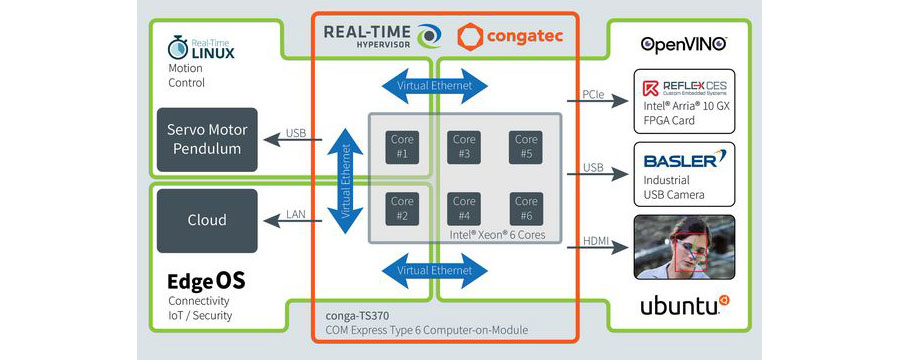Don’t Start from Zero, Start with an IoT Development Kit

Industrial IoT edge devices are integrating more intelligence, networking, and security functionality alongside traditional sensing, actuation, and control tasks. As a result, workload consolidation has become more of a necessity than a luxury. Combining multiple capabilities onto a single system reduces overall component costs, power consumption, hardware footprint, cabling, and other capital and operating expenses.
The end-user benefits are obvious, but where does that leave OEMs and system integrators looking to develop workload-consolidated devices quickly and at scale? Prototyping such systems requires engineering teams to build each subsystem separately, then incorporate those discrete designs into one, unified workload-consolidated architecture.
Workload Consolidation’s Prototyping Problem
Consider an industrial vision system that scans for defective products on an automation line. Today, these systems use neural networking algorithms to search for production flaws. They also support deterministic but IT-friendly communications technologies like Ethernet TSN, and therefore require advanced on-board security. In addition, they must also send control signals to a PLC driving the automation line in microseconds if production anomalies are detected.
In early-stage development, this means investing in a range of target equipment that supports each desired task—just as you would have in a conventional system architecture.
“If you do it the traditional way, the motion control part would be a PLC in its own box connected by Ethernet to a switch,” said Christian Eder, Director of Marketing at congatec. “Then, of course, we have a cloud connector, which is typically another box that handles secure communication to outside applications like an AI camera.” (Figure 1)

Just the simple cost of hardware may be double compared to putting everything in a single box that needs a slightly faster CPU. And this doesn’t even account for software integration, which could consume hundreds of engineering hours to ensure that the various components operate as expected in the final system.
Workload consolidation dev? “Don’t start from zero. Start from 90 percent and optimize the remaining 10 percent.” —Christian Eder,
@congatecAG
Less Work with an IIoT Development Kit
To address the systems integration gap in these designs, congatec introduced a workload consolidation proof of concept (PoC) at embedded world 2019 (Video 1). Nearly a year later, the company has partnered with Intel® to make the PoC available as an off-the-shelf Workload Consolidation Starter Set for OEMs and system integrators.
Video 1. congatec’s workload consolidation PoC combines real-time control, computer vision, and cloud connectivity on a single device. (Source: Embedded Computing Design)
As shown in Figure 2, the workload consolidation kit is based on the congatec Conga-TS370 COM Express Type 6 board, which sports a six-core Intel® Xeon® processor. These cores are isolated from one another using a real-time embedded hypervisor from Real-Time Systems, allowing the congatec kit to combine three separate subsystems that are connected via virtual Ethernet:
Machine Vision—A Ubuntu Linux-based vision system consumes four cores, but integrates a Basler industrial USB camera and Arria® 10 FPGA acceleration card from ReFLEX CES. Computer vision algorithms developed using the Intel® OpenVINO™ Toolkit run on top of the desktop OS.
Cloud Connectivity—An additional core runs EdgeOS, a small-footprint Linux implementation that owns the kit’s physical Ethernet port and supports enterprise connectivity like MQTT. It also provides secure gateway functionality, acting as a firewall between the other subsystems and the outside world.
Real-Time Control—The final core runs a real-time Linux OS that manages the system’s control-oriented tasks, functioning much like a PLC. To demonstrate this, the kit interfaces to a servo-driven pendulum via USB.

Out of the box, the Workload Consolidation Starter Set comes with the hypervisor pre-configured, the OSs loaded, and access to networking stacks and OpenVINO AI libraries. This combination reduces both development costs and time to market for organizations looking to streamline the design of robust industrial IoT edge solutions.
“Of course, having everything on one platform is much easier to maintain,” Eder said. “The complete environment is set up. You can immediately begin to optimize the specific details of your application.”
“Don’t start from zero. Start from 90 percent and optimize the remaining 10 percent,” he added.
The Last Mile of an Embedded System Prototype
With the value of electronic systems increasingly shifting toward application software and services, technology reuse is critical in the deeply embedded portions of any design. The Workload Consolidation Starter Set abstracts the complexities of that underlying technology while allowing IoT engineering organizations to focus on core value adds without worrying about complex software integration down the road.
Obviously the kit itself may not be optimized for every possible use case right out of the box, but engineering services from congatec and others can tweak hardware and software subsystems to ensure that ultimate design goals are met.
Workload consolidation solutions now get you 90 percent of the way to your end product. What will you do in the last mile?